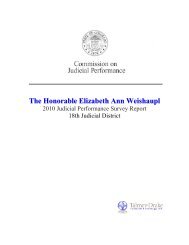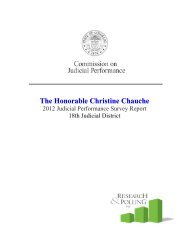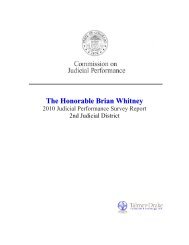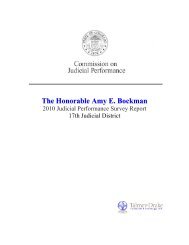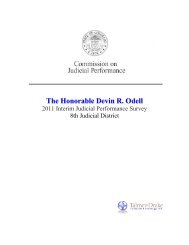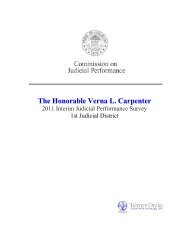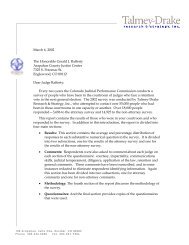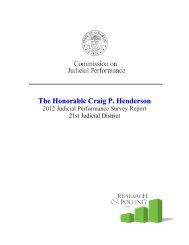2009 Interim Survey Report - Commissions on Judicial Performance
2009 Interim Survey Report - Commissions on Judicial Performance
2009 Interim Survey Report - Commissions on Judicial Performance
Create successful ePaper yourself
Turn your PDF publications into a flip-book with our unique Google optimized e-Paper software.
State of Colorado Logo<br />
COMMISSION ON JUDICIAL PERFORMANCE<br />
The H<strong>on</strong>orable James B. Breese<br />
<str<strong>on</strong>g>2009</str<strong>on</strong>g> <str<strong>on</strong>g>Interim</str<strong>on</strong>g> <strong>Judicial</strong> <strong>Performance</strong> <str<strong>on</strong>g>Survey</str<strong>on</strong>g><br />
2nd <strong>Judicial</strong> District
September 24, <str<strong>on</strong>g>2009</str<strong>on</strong>g><br />
The H<strong>on</strong>orable James B. Breese<br />
City & County Bldg.<br />
1437 Bannock St., Room 108<br />
Denver, CO 80202<br />
Dear Judge Breese:<br />
This year, The State Commissi<strong>on</strong> <strong>on</strong> <strong>Judicial</strong> <strong>Performance</strong> has requested Talmey-<br />
Drake Research & Strategy to provide interim survey reports c<strong>on</strong>cerning all justices<br />
and judges. Going forward, there will c<strong>on</strong>tinue to be survey reports <strong>on</strong> retenti<strong>on</strong><br />
judges in retenti<strong>on</strong> electi<strong>on</strong> years and interim survey reports <strong>on</strong> all judges in n<strong>on</strong>retenti<strong>on</strong><br />
years.<br />
Talmey-Drake Research & Strategy c<strong>on</strong>ducted the <str<strong>on</strong>g>2009</str<strong>on</strong>g> <str<strong>on</strong>g>Interim</str<strong>on</strong>g> <strong>Judicial</strong> <strong>Performance</strong><br />
<str<strong>on</strong>g>Survey</str<strong>on</strong>g> am<strong>on</strong>g people who have been in a state courtroom in <strong>on</strong>ce capacity or<br />
another, or who have otherwise been affected by the performance of a judge.<br />
This report c<strong>on</strong>tains the results of those who have observed, or who are<br />
knowledgeable about, your judicial performance and who resp<strong>on</strong>ded to the survey.<br />
In additi<strong>on</strong> to this introducti<strong>on</strong>, the report is divided into four main secti<strong>on</strong>s:<br />
Attorney Results & Comments: This secti<strong>on</strong> c<strong>on</strong>tains graphs displaying the<br />
average grade you received for each questi<strong>on</strong> that used an “A” to “F” scale,<br />
the average grade for each secti<strong>on</strong> of the questi<strong>on</strong>naire, and an overall<br />
average grade for questi<strong>on</strong>s 1a through 5c combined. Following the graphs,<br />
are a series of tables showing the percentage distributi<strong>on</strong> of grades to each<br />
questi<strong>on</strong>. Attorney resp<strong>on</strong>dents were also asked to comment about your<br />
performance. These comments have been transcribed, and in some<br />
instances, redacted to eliminate resp<strong>on</strong>dent identifying informati<strong>on</strong>. The<br />
survey of attorneys was c<strong>on</strong>ducted <strong>on</strong>line; a copy of the questi<strong>on</strong>naire is<br />
provided at the back of this report.<br />
N<strong>on</strong>-attorney Results & Comments: Similar to the attorney secti<strong>on</strong>, this<br />
porti<strong>on</strong> of the report c<strong>on</strong>tains graphs (again including the overall average of<br />
questi<strong>on</strong>s 1a through 5c <strong>on</strong> the n<strong>on</strong>-attorney questi<strong>on</strong>naire), tables of the<br />
percentage distributi<strong>on</strong> of grades for each substantive questi<strong>on</strong> in the survey.<br />
The n<strong>on</strong>-attorney resp<strong>on</strong>dents were also asked to comment about your<br />
performance. Again, these comments have been transcribed, and in some<br />
instances redacted to eliminate resp<strong>on</strong>dent identifying informati<strong>on</strong>. A copy<br />
of the n<strong>on</strong>-attorney questi<strong>on</strong>naire is also at the back of this report.<br />
Methodology: The third secti<strong>on</strong> of the report discusses the methodology of<br />
the survey.<br />
1 0 0 Arapahoe, Sui te One , Boulde r, CO 80302<br />
P h o n e 3 0 3 . 4 4 3 . 5 3 0 0 Fax 3 0 3 . 4 4 7 . 9 3 8 6
The H<strong>on</strong>orable James B. Breese<br />
September 24, <str<strong>on</strong>g>2009</str<strong>on</strong>g><br />
Page 2<br />
Questi<strong>on</strong>naires: And the final secti<strong>on</strong> provides copies of the questi<strong>on</strong>naires<br />
that were used.<br />
If you have any questi<strong>on</strong>s about the methodology and how the survey was<br />
c<strong>on</strong>ducted, please feel free to c<strong>on</strong>tact me at 303-443-5300 ext 1, and for any other<br />
questi<strong>on</strong>s you might have about the survey please call the Executive Director of the<br />
Office of <strong>Judicial</strong> <strong>Performance</strong> Evaluati<strong>on</strong>, Jane Howell, at 303-837-3665.<br />
Best regards,<br />
Paul A. Talmey<br />
President<br />
enc:
<str<strong>on</strong>g>Survey</str<strong>on</strong>g> of Attorneys Regarding<br />
Judge James B. Breese<br />
(Sample Size 27)
<str<strong>on</strong>g>Survey</str<strong>on</strong>g> of Attorneys Regarding Trial Judges<br />
Judge James B. Breese<br />
Sample Size = 27<br />
A B C D Fail DK/NA<br />
James B.<br />
Breese<br />
Average<br />
All County<br />
Judges<br />
1. Case Management:<br />
1a. Promptly issuing a decisi<strong>on</strong> <strong>on</strong> the case after trial. 48% 19% 4% 0% 0% 30% 3.63 3.48<br />
1b. Maintaining appropriate c<strong>on</strong>trol over proceedings. 74% 22% 4% 0% 0% 0% 3.70 3.40<br />
1c. Promptly ruling <strong>on</strong> pre-trial moti<strong>on</strong>s. 59% 11% 7% 7% 0% 15% 3.43 3.36<br />
1d. Setting reas<strong>on</strong>able schedules for cases. 77% 15% 4% 4% 0% 0% 3.65 3.35<br />
2. Applicati<strong>on</strong> and Knowledge of Law:<br />
Overall Case Management<br />
3.60 3.40<br />
2a. Being able to identify and analyze relevant facts. 81% 15% 4% 0% 0% 0% 3.78 3.25<br />
2b. Basing decisi<strong>on</strong>s <strong>on</strong> evidence and arguments. 74% 15% 11% 0% 0% 0% 3.63 3.15<br />
2c. Willing to rec<strong>on</strong>sider error in fact or law. 54% 12% 0% 0% 0% 35% 3.82 2.95<br />
2d. Issuing c<strong>on</strong>sistent sentences when the circumstances are<br />
similar.<br />
63% 19% 7% 0% 0% 11% 3.62 3.20<br />
3. Communicati<strong>on</strong>s:<br />
Overall Applicati<strong>on</strong> and Knowledge of Law<br />
3.71 3.14<br />
3a. Making sure all participants understand the proceedings. 78% 19% 4% 0% 0% 0% 3.74 3.49<br />
3b. Providing written communicati<strong>on</strong>s that are clear, thorough 72% 17% 0% 0% 0% 11% 3.81 3.23<br />
and well reas<strong>on</strong>ed.<br />
4. Demeanor:<br />
Overall Communicati<strong>on</strong>s<br />
3.78 3.36<br />
4a. Giving proceedings a sense of dignity. 85% 7% 7% 0% 0% 0% 3.78 3.40<br />
4b. Treating parties with respect. 89% 7% 4% 0% 0% 0% 3.85 3.37<br />
4c. C<strong>on</strong>ducting his/her courtroom in a neutral manner. 78% 19% 4% 0% 0% 0% 3.74 3.20<br />
4d. C<strong>on</strong>sistently applying laws and rules. 85% 0% 11% 0% 0% 4% 3.77 3.22<br />
5. Diligence:<br />
5a. Using good judgment in applicati<strong>on</strong> of relevant law and<br />
rules.<br />
5b. Doing the necessary homework and being prepared for<br />
his/her cases.<br />
5c. Being willing to handle cases <strong>on</strong> the docket even when<br />
they are complicated and time c<strong>on</strong>suming.<br />
Overall Demeanor<br />
3.79 3.30<br />
67% 26% 7% 0% 0% 0% 3.59 3.16<br />
56% 30% 7% 0% 0% 7% 3.52 3.23<br />
70% 11% 4% 0% 0% 15% 3.78 3.35<br />
Overall Diligence<br />
3.63 3.25<br />
Overall Average Grade:<br />
3.70 3.28<br />
<str<strong>on</strong>g>2009</str<strong>on</strong>g> <str<strong>on</strong>g>Interim</str<strong>on</strong>g> <strong>Judicial</strong> <strong>Performance</strong> <str<strong>on</strong>g>Survey</str<strong>on</strong>g><br />
2
<str<strong>on</strong>g>Survey</str<strong>on</strong>g> of Attorneys Regarding Trial Judges<br />
Judge James B. Breese<br />
James B.<br />
Sample Size = 27<br />
Percentage<br />
Breese<br />
All County<br />
Judges<br />
Would you say the judge is:<br />
Very biased in favor of the prosecuti<strong>on</strong><br />
Somewhat biased in favor of the prosecuti<strong>on</strong><br />
Completely neutral<br />
Somewhat biased in favor of the defense<br />
Very biased in favor of the defense<br />
D<strong>on</strong>'t know/not sure<br />
6% 10%<br />
28% 30%<br />
61% 46%<br />
0% 7%<br />
0% 2%<br />
6% 5%<br />
8. How str<strong>on</strong>gly do you recommend that the Judge be retained or not retained in<br />
office<br />
[Percentages excluding undecided resp<strong>on</strong>ses.]<br />
Str<strong>on</strong>gly recommend retain in office<br />
Somewhat recommend retain in office<br />
Somewhat recommend not retain in office<br />
Str<strong>on</strong>gly recommend not retain in office<br />
81% 70%<br />
19% 16%<br />
0% 7%<br />
0% 7%<br />
Total Retain<br />
Total Not Retain<br />
100%<br />
0%<br />
86%<br />
14%<br />
[Percentages including undecided resp<strong>on</strong>ses.]<br />
Str<strong>on</strong>gly recommend retain in office<br />
Somewhat recommend retain in office<br />
Undecided or d<strong>on</strong>t know enough to make recommendati<strong>on</strong><br />
Somewhat recommend not retain in office<br />
Str<strong>on</strong>gly recommend not retain in office<br />
81% 66%<br />
19% 16%<br />
0% 5%<br />
0% 6%<br />
0% 7%<br />
Total Retain 100% 82%<br />
Undecided/D<strong>on</strong>'t Know 0% 5%<br />
Total Not Retain 0% 13%<br />
<str<strong>on</strong>g>2009</str<strong>on</strong>g> <str<strong>on</strong>g>Interim</str<strong>on</strong>g> <strong>Judicial</strong> <strong>Performance</strong> <str<strong>on</strong>g>Survey</str<strong>on</strong>g><br />
3
Judge James B. Breese<br />
<str<strong>on</strong>g>Survey</str<strong>on</strong>g> of Attorneys Regarding Trial Judges<br />
Average Grades<br />
Overall Average Grade<br />
3.28<br />
3.70<br />
Q1. Overall Case Management<br />
1a. Promptly issuing a decisi<strong>on</strong> <strong>on</strong> the<br />
case after trial.<br />
1b. Maintaining appropriate c<strong>on</strong>trol over<br />
proceedings.<br />
1c. Promptly ruling <strong>on</strong> pre-trial moti<strong>on</strong>s.<br />
1d. Setting reas<strong>on</strong>able schedules for cases.<br />
3.40<br />
3.48<br />
3.40<br />
3.43<br />
3.36<br />
3.35<br />
3.60<br />
3.63<br />
3.70<br />
3.65<br />
Q2. Overall App & Knowledge of Law<br />
3.14<br />
3.71<br />
2a. Being able to identify and analyze<br />
relevant facts.<br />
3.25<br />
3.78<br />
2b. Basing decisi<strong>on</strong>s <strong>on</strong> evidence and argument.<br />
3.15<br />
3.63<br />
2c. Willing to rec<strong>on</strong>sider error in fact or law.<br />
2.95<br />
3.82<br />
2d. [Criminal <strong>on</strong>ly] Issuing c<strong>on</strong>sistant sentences<br />
when circumstances are simmilar.<br />
3.20<br />
3.62<br />
Q3. Overall Communicati<strong>on</strong><br />
3.36<br />
3.78<br />
3a. Making sure all participants understand<br />
the proceedings.<br />
3.49<br />
3.74<br />
3b. Providing written communicati<strong>on</strong>s that are<br />
clear, thorough and well reas<strong>on</strong>ed.<br />
3.23<br />
3.81<br />
2.0 2.5 3.0 3.5 4.0<br />
James B. Breese<br />
All County Judges<br />
<str<strong>on</strong>g>2009</str<strong>on</strong>g> <str<strong>on</strong>g>Interim</str<strong>on</strong>g> <strong>Judicial</strong> <strong>Performance</strong> <str<strong>on</strong>g>Survey</str<strong>on</strong>g><br />
Judge James B. Breese<br />
4
Judge James B. Breese<br />
<str<strong>on</strong>g>Survey</str<strong>on</strong>g> of Attorneys Regarding Trial Judges<br />
Average Grades<br />
Q4. Overall Demeanor<br />
4a. Giving proceedings a sense of dignity.<br />
4b. Treating participants with respect.<br />
4c. C<strong>on</strong>ducting [his/her] courtroom<br />
in a neutral manner.<br />
4d. C<strong>on</strong>sistanly applying laws and rules<br />
3.30<br />
3.40<br />
3.37<br />
3.20<br />
3.22<br />
3.79<br />
3.78<br />
3.85<br />
3.74<br />
3.77<br />
Q5. Overall Diligence<br />
5a. Using good judgement in applicati<strong>on</strong> of<br />
releveant laws and rules.<br />
5b. Doing the necessary 'homework' and<br />
being prepared for [his/her] cases.<br />
3.16<br />
3.25<br />
3.23<br />
3.52<br />
3.63<br />
3.59<br />
5c. Being willing to handle cases <strong>on</strong> the docket even<br />
when they are complicated and time c<strong>on</strong>suming.<br />
3.35<br />
3.78<br />
2.0 2.5 3.0 3.5 4.0<br />
Biased in favor of prosecuti<strong>on</strong>/defense.<br />
Very biased in favor of the prosecuti<strong>on</strong><br />
Somewhat biased in favor of the prosecuti<strong>on</strong><br />
Completely Neutral<br />
Somewhat biased in favor of the defense<br />
Very biased in favor of the defense<br />
D<strong>on</strong>'t know/not sure<br />
6%<br />
10%<br />
0%<br />
7%<br />
0%<br />
2%<br />
6%<br />
5%<br />
28%<br />
30%<br />
46%<br />
61%<br />
0% 10% 20% 30% 40% 50% 60% 70%<br />
James B. Breese<br />
All County Judges<br />
<str<strong>on</strong>g>2009</str<strong>on</strong>g> <str<strong>on</strong>g>Interim</str<strong>on</strong>g> <strong>Judicial</strong> <strong>Performance</strong> <str<strong>on</strong>g>Survey</str<strong>on</strong>g><br />
5
Judge James B. Breese<br />
<str<strong>on</strong>g>Survey</str<strong>on</strong>g> of Attorneys Regarding Trial Judges<br />
Q8. How str<strong>on</strong>gly do you recommend that Judge Breese be retained or not<br />
retained in office<br />
Excluding Undecided Resp<strong>on</strong>dents<br />
Str<strong>on</strong>gly recommend retain in office<br />
70%<br />
81%<br />
Somewhat recommend retain in office<br />
Somewhat recommend not retain in office<br />
0%<br />
7%<br />
19%<br />
16%<br />
Judge Breese<br />
All Cnty<br />
Judges<br />
Total Retain 100% 86%<br />
Total Not Retain 0% 14%<br />
Str<strong>on</strong>gly recommend not retain in office<br />
0%<br />
7%<br />
0% 10% 20% 30% 40% 50% 60% 70% 80% 90% 100%<br />
Including Undecided Resp<strong>on</strong>dents<br />
Str<strong>on</strong>gly recommend retain in office<br />
66%<br />
81%<br />
Somewhat recommend retain in office<br />
Undecided<br />
Somewhat recommend not retain in office<br />
0%<br />
5%<br />
0%<br />
6%<br />
19%<br />
16%<br />
Judge Breese<br />
All Cnty<br />
Judges<br />
Total Retain 100% 82%<br />
Undecided 0% 5%<br />
Total Not Retain 0% 13%<br />
Str<strong>on</strong>gly recommend not retain in office<br />
0%<br />
7%<br />
0% 10% 20% 30% 40% 50% 60% 70% 80% 90% 100%<br />
James B. Breese<br />
All County Judges<br />
<str<strong>on</strong>g>2009</str<strong>on</strong>g> <str<strong>on</strong>g>Interim</str<strong>on</strong>g> <strong>Judicial</strong> <strong>Performance</strong> <str<strong>on</strong>g>Survey</str<strong>on</strong>g><br />
6
<str<strong>on</strong>g>Survey</str<strong>on</strong>g> of N<strong>on</strong>-Attorneys Regarding<br />
Judge James B. Breese<br />
(Sample Size 238)
<str<strong>on</strong>g>Survey</str<strong>on</strong>g> of N<strong>on</strong>-Attorneys Regarding Trial Judges<br />
Judge James B. Breese<br />
Sample Size = 238<br />
A B C D Fail DK/NA<br />
James B.<br />
Breese<br />
Average<br />
All County<br />
Judges<br />
1. Demeanor:<br />
1a. Giving court proceedings a sense of dignity. 85% 9% 3% 1% 1% 1% 3.78 3.52<br />
1b. Treating participants in the case politely and with respect. 86% 9% 2% 0% 1% 1% 3.81 3.53<br />
1c. C<strong>on</strong>ducting court in a neutral manner. 87% 7% 3% 1% 2% 1% 3.78 3.47<br />
1d. Having a sense of compassi<strong>on</strong> and human understanding<br />
for those who appear before the court.<br />
83% 9% 3% 1% 2% 3% 3.76 3.39<br />
2. Fairness:<br />
Overall Demeanor<br />
3.78 3.48<br />
2a. Giving participants an opportunity to be heard. 86% 8% 2% 1% 1% 2% 3.80 3.53<br />
2b. Treating those involved in the case without bias. 86% 7% 2% 1% 1% 2% 3.79 3.43<br />
2c. Treating fairly people who represent themselves. 55% 5% 2% 0% 1% 37% 3.77 3.42<br />
2d. Giving each side enough time to present his or her case. 85% 9% 2% 1% 1% 2% 3.80 3.52<br />
3. Communicati<strong>on</strong>s:<br />
Overall Fairness<br />
3.79 3.48<br />
3a. Making sure participants understand the proceedings, and 89% 6% 3% 0% 1% 1% 3.84 3.58<br />
what is going <strong>on</strong> in the courtroom.<br />
3b. Using language that every<strong>on</strong>e can understand. 86% 10% 2% 0% 1% 1% 3.81 3.61<br />
3c. Speaking clearly so every<strong>on</strong>e in the courtroom can hear<br />
what is being said.<br />
89% 8% 2% 1% 0% 1% 3.85 3.65<br />
4. Diligence:<br />
Overall Communicati<strong>on</strong>s<br />
3.83 3.61<br />
4a. Beginning court <strong>on</strong> time 55% 24% 13% 2% 3% 4% 3.33 3.36<br />
4b. Maintaining appropriate c<strong>on</strong>trol over proceedings. 85% 10% 1% 1% 1% 1% 3.78 3.62<br />
4c. Setting reas<strong>on</strong>able schedules for cases. 67% 12% 3% 1% 3% 15% 3.64 3.50<br />
4d. Being prepared for cases. 76% 9% 2% 1% 1% 10% 3.76 3.54<br />
4e. Managing court proceedings so that there is little wasted<br />
time.<br />
71% 19% 4% 3% 3% 1% 3.54 3.43<br />
5. Applicati<strong>on</strong> of Law:<br />
Overall Diligence<br />
3.61 3.49<br />
5a. Giving reas<strong>on</strong>s for rulings. 78% 9% 3% 0% 1% 9% 3.77 3.41<br />
5b. Willing to make decisi<strong>on</strong>s without regard to possible 66% 6% 1% 0% 2% 24% 3.76 3.43<br />
outside pressure.<br />
5c. Being able to identify and analyze relevant facts. 75% 10% 2% 0% 2% 10% 3.75 3.42<br />
Overall Applicati<strong>on</strong> of Law<br />
3.76 3.42<br />
Overall Average Grade:<br />
3.75 3.49<br />
<str<strong>on</strong>g>2009</str<strong>on</strong>g> <str<strong>on</strong>g>Interim</str<strong>on</strong>g> <strong>Judicial</strong> <strong>Performance</strong> <str<strong>on</strong>g>Survey</str<strong>on</strong>g><br />
8
<str<strong>on</strong>g>Survey</str<strong>on</strong>g> of N<strong>on</strong>-Attorneys Regarding Trial Judges<br />
Judge James B. Breese<br />
Sample Size = 238<br />
Percentage<br />
James B.<br />
Breese<br />
All County<br />
Judges<br />
6. Average bias<br />
[Please see the questi<strong>on</strong>naire at the end of<br />
report for questi<strong>on</strong> wording.]<br />
[A positive average indicates bias toward prosecuti<strong>on</strong>, and a<br />
negative average indicates a bias toward the defense.]<br />
7. Average sentencing<br />
[Please see the questi<strong>on</strong>naire at the end of<br />
report for questi<strong>on</strong> wording.]<br />
[A positive average indicates sentences are harsh, and a<br />
negative average indicates sentences are lenient.]<br />
Biased in favor of the prosecuti<strong>on</strong> total<br />
Competely neutral<br />
Biased in favor of the defense total<br />
Average<br />
Harsh sentencing total<br />
Competely neutral<br />
Lenient sentencing total<br />
Average<br />
5% 14%<br />
88% 77%<br />
7% 8%<br />
-0.04 0.15<br />
5% 16%<br />
85% 73%<br />
10% 12%<br />
-0.18 0.15<br />
10. Retain percentage without undecideds.<br />
[Percentages excluding undecided resp<strong>on</strong>ses.]<br />
Str<strong>on</strong>gly recommend retain in office<br />
Somewhat recommend retain in office<br />
Somewhat recommend not retain in office<br />
Str<strong>on</strong>gly recommend not retain in office<br />
92% 81%<br />
5% 9%<br />
0% 3%<br />
3% 7%<br />
Total Retain<br />
Total Not Retain<br />
97%<br />
3%<br />
90%<br />
10%<br />
[Percentages including undecided resp<strong>on</strong>ses.]<br />
Str<strong>on</strong>gly recommend retain in office<br />
Somewhat recommend retain in office<br />
Undecided or d<strong>on</strong>t know enough to make recommendati<strong>on</strong><br />
Somewhat recommend not retain in office<br />
Str<strong>on</strong>gly recommend not retain in office<br />
88% 74%<br />
5% 8%<br />
4% 9%<br />
0% 3%<br />
3% 6%<br />
Total Retain 93% 82%<br />
Undecided/D<strong>on</strong>'t Know 4% 9%<br />
Total Not Retain 3% 9%<br />
<str<strong>on</strong>g>2009</str<strong>on</strong>g> <str<strong>on</strong>g>Interim</str<strong>on</strong>g> <strong>Judicial</strong> <strong>Performance</strong> <str<strong>on</strong>g>Survey</str<strong>on</strong>g><br />
9
Judge James B. Breese<br />
<str<strong>on</strong>g>Survey</str<strong>on</strong>g> of N<strong>on</strong>-Attorneys Regarding Trial Judges<br />
Average Grades<br />
Overall Average Grade<br />
3.49<br />
3.75<br />
Q1. Overall Demeanor<br />
1a. Giving proceedings a sense of dignity.<br />
1b. Treating participants politely and with respect.<br />
1c. C<strong>on</strong>ducting the courtroom in a neutral<br />
manner.<br />
1d. Having a sense of compassi<strong>on</strong> and human<br />
understanding for those who appear before the judge<br />
3.48<br />
3.52<br />
3.53<br />
3.47<br />
3.39<br />
3.78<br />
3.78<br />
3.81<br />
3.78<br />
3.76<br />
Q2. Overall Fairness<br />
2a. Giving participants an opportunity to be<br />
heard.<br />
2b. Treating those involved in the<br />
case without bias.<br />
2c. Treats people fairly who represent<br />
themselves.<br />
2d. Giving each side enough time to present his<br />
or her case.<br />
3.48<br />
3.53<br />
3.43<br />
3.42<br />
3.52<br />
3.79<br />
3.80<br />
3.79<br />
3.77<br />
3.80<br />
Q3. Overall Communticati<strong>on</strong>s<br />
3a. Making sure participants understand the<br />
proceedings, and what's going <strong>on</strong> in the courtroom.<br />
3b. Using language that every<strong>on</strong>e can<br />
understand.<br />
3.61<br />
3.58<br />
3.61<br />
3.83<br />
3.84<br />
3.81<br />
3c. Speaking clearly so every<strong>on</strong>e in the courtroom<br />
can hear what's being said.<br />
3.65<br />
3.85<br />
2.0 2.5 3.0 3.5 4.0<br />
James B. Breese<br />
All County Judges<br />
<str<strong>on</strong>g>2009</str<strong>on</strong>g> <str<strong>on</strong>g>Interim</str<strong>on</strong>g> <strong>Judicial</strong> <strong>Performance</strong> <str<strong>on</strong>g>Survey</str<strong>on</strong>g><br />
Judge James B. Breese<br />
10
James B. Breese<br />
All County Judges<br />
James B. Breese<br />
All County Judges<br />
Judge James B. Breese<br />
<str<strong>on</strong>g>Survey</str<strong>on</strong>g> of N<strong>on</strong>-Attorneys Regarding Trial Judges<br />
Average Grades<br />
Q4. Overall Diligence<br />
4a. Beginning court <strong>on</strong> time.<br />
4b. Maintaining appropriate c<strong>on</strong>trol over<br />
proceedings.<br />
4c. Setting reas<strong>on</strong>able schedules for cases.<br />
4d. Being prepared for his or her cases.<br />
4e. Managing court proceedings so that there is<br />
little wasted time.<br />
3.33<br />
3.36<br />
3.61<br />
3.49<br />
3.78<br />
3.62<br />
3.64<br />
3.50<br />
3.76<br />
3.54<br />
3.54<br />
3.43<br />
Q5. Overall Legal Ability<br />
5a. Giving reas<strong>on</strong>s for rulings.<br />
5b. Willing to make decisi<strong>on</strong> without regard to<br />
possible outside pressure.<br />
5c. Being able to identify and analyze<br />
relevant facts.<br />
3.42<br />
3.41<br />
3.43<br />
3.42<br />
3.76<br />
3.77<br />
3.76<br />
3.75<br />
2.0 2.5 3.0 3.5 4.0<br />
Q6 Biased in favor of prosecuti<strong>on</strong>/defense.<br />
-0.04<br />
0.15<br />
-5 -4 -3 -2 -1 0 1 2 3 4 5<br />
Defense<br />
Prosecuti<strong>on</strong> <br />
Q7 Lenience or Harshness in Sentencing.<br />
-0.18<br />
0.15<br />
-5 -4 -3 -2 -1 0 1 2 3 4 5<br />
Lenient<br />
James B. Breese All County Judges<br />
<str<strong>on</strong>g>2009</str<strong>on</strong>g> <str<strong>on</strong>g>Interim</str<strong>on</strong>g> <strong>Judicial</strong> <strong>Performance</strong> <str<strong>on</strong>g>Survey</str<strong>on</strong>g><br />
Harsh <br />
11
James B. Breese<br />
All County Judges<br />
Judge James B. Breese<br />
<str<strong>on</strong>g>Survey</str<strong>on</strong>g> of N<strong>on</strong>-Attorneys Regarding Trial Judges<br />
Q10. How str<strong>on</strong>gly do you recommend that Judge Breese be retained or not<br />
retained in office<br />
Excluding Undecided Resp<strong>on</strong>dents<br />
Str<strong>on</strong>gly recommend retain in office<br />
81%<br />
92%<br />
Somewhat recommend retain in office<br />
Somewhat recommend not retain in office<br />
5%<br />
9%<br />
0%<br />
3%<br />
Judge Breese<br />
All Cnty<br />
Judges<br />
Total Retain 97% 90%<br />
Total Not Retain 3% 10%<br />
Str<strong>on</strong>gly recommend not retain in office<br />
3%<br />
7%<br />
0% 10% 20% 30% 40% 50% 60% 70% 80% 90% 100%<br />
Including Undecided Resp<strong>on</strong>dents<br />
Str<strong>on</strong>gly recommend retain in office<br />
74%<br />
88%<br />
Somewhat recommend retain in office<br />
5%<br />
8%<br />
Undecided<br />
Somewhat recommend not retain in office<br />
4%<br />
9%<br />
0%<br />
3%<br />
Judge Breese<br />
All Cnty<br />
Judges<br />
Total Retain 93% 82%<br />
Undecided 4% 9%<br />
Total Not Retain 3% 9%<br />
Str<strong>on</strong>gly recommend not retain in office<br />
3%<br />
6%<br />
0% 10% 20% 30% 40% 50% 60% 70% 80% 90% 100%<br />
James B. Breese<br />
All County Judges<br />
<str<strong>on</strong>g>2009</str<strong>on</strong>g> <str<strong>on</strong>g>Interim</str<strong>on</strong>g> <strong>Judicial</strong> <strong>Performance</strong> <str<strong>on</strong>g>Survey</str<strong>on</strong>g><br />
12
Methodology
Methodology<br />
Data Sources for Sample<br />
Talmey-Drake Research & Strategy received case data that included the names of<br />
people who had likely been in each judge’s courtroom between July 1, 2008 and<br />
March 31, <str<strong>on</strong>g>2009</str<strong>on</strong>g> from five primary sources:<br />
Colorado <strong>Judicial</strong> Department,<br />
Colorado District Attorneys’ Council<br />
Denver County Courts<br />
District Attorney’s Office, Sec<strong>on</strong>d <strong>Judicial</strong> District (Denver)<br />
District Attorney’s Office, Ninth <strong>Judicial</strong> District<br />
Additi<strong>on</strong>al informati<strong>on</strong> was provided by the State Public Defender’s Office and<br />
the District Attorney’s Office, 15th <strong>Judicial</strong> District.<br />
The data from these different data sources were then combined, duplicates<br />
removed and addresses corrected.<br />
Talmey-Drake then c<strong>on</strong>ducted two separate surveys for the <str<strong>on</strong>g>2009</str<strong>on</strong>g> Colorado<br />
<str<strong>on</strong>g>Interim</str<strong>on</strong>g> <strong>Judicial</strong> <strong>Performance</strong> <str<strong>on</strong>g>Survey</str<strong>on</strong>g> c<strong>on</strong>cerning county judges: A survey of<br />
attorneys and a survey of n<strong>on</strong>-attorneys who had likely been in County Court.<br />
Resp<strong>on</strong>ses to surveys c<strong>on</strong>ducted in prior years that had not been used in a<br />
previous <strong>Judicial</strong> <strong>Performance</strong> report were combined with the above data to<br />
create the total sample used in the <str<strong>on</strong>g>2009</str<strong>on</strong>g> Colorado <str<strong>on</strong>g>Interim</str<strong>on</strong>g> <strong>Judicial</strong> <strong>Performance</strong><br />
<str<strong>on</strong>g>Survey</str<strong>on</strong>g>.<br />
Attorney <str<strong>on</strong>g>Survey</str<strong>on</strong>g><br />
Attorney Sample: Talmey-Drake identified all the attorneys who were in the<br />
data provided by the organizati<strong>on</strong>s listed above, and all identified attorneys<br />
were included in the sample. As to be expected many attorneys had appeared in<br />
more than <strong>on</strong>e judge’s courtroom, so each attorney was assigned from <strong>on</strong>e to five<br />
judges to evaluate, depending <strong>on</strong> how many different judges with whom he or<br />
she was associated in the case data. For those attorneys who were in the case<br />
data for more than five judges, they were asked to evaluate the five judges they<br />
were associated with the most.<br />
<str<strong>on</strong>g>2009</str<strong>on</strong>g> <str<strong>on</strong>g>Interim</str<strong>on</strong>g> <strong>Judicial</strong> <strong>Performance</strong> <str<strong>on</strong>g>Survey</str<strong>on</strong>g><br />
14
Attorney <str<strong>on</strong>g>Survey</str<strong>on</strong>g>: The Attorney <str<strong>on</strong>g>Survey</str<strong>on</strong>g> was c<strong>on</strong>ducted <strong>on</strong>line. Sampled<br />
attorneys were first sent a letter introducing them to the <str<strong>on</strong>g>Survey</str<strong>on</strong>g> and informing<br />
them that they would so<strong>on</strong> be receiving an email with a link to the <str<strong>on</strong>g>Survey</str<strong>on</strong>g>. The<br />
letter also included the <str<strong>on</strong>g>Survey</str<strong>on</strong>g>’s Web address, and a password if the resp<strong>on</strong>dent<br />
wished to take the survey before receiving the email. Approximately <strong>on</strong>e week<br />
after the letter was mailed a first email was sent, and a week after that a sec<strong>on</strong>d<br />
reminder email was sent.<br />
In order to increase the number of attorney resp<strong>on</strong>ses, particularly for judges<br />
with few attorney survey evaluati<strong>on</strong>s, attorneys who had not resp<strong>on</strong>ded after the<br />
sec<strong>on</strong>d email request were teleph<strong>on</strong>ed and asked to either go <strong>on</strong>line to take the<br />
survey, or if they preferred, to complete the survey by teleph<strong>on</strong>e.<br />
Attorney Questi<strong>on</strong>s: The questi<strong>on</strong>s used <strong>on</strong>line for the <str<strong>on</strong>g>2009</str<strong>on</strong>g> <str<strong>on</strong>g>Interim</str<strong>on</strong>g> <strong>Judicial</strong><br />
<strong>Performance</strong> <str<strong>on</strong>g>Survey</str<strong>on</strong>g> of attorneys asked resp<strong>on</strong>dents to use a grade of A, B, C, D,<br />
or F (Fail) to assess the judge’s performance in five different areas. These areas<br />
were Case Management, Applicati<strong>on</strong> and Knowledge of Law, Communicati<strong>on</strong>s,<br />
Demeanor and Diligence. These scores were then c<strong>on</strong>verted to a numerical value<br />
where A = 4, B = 3, C = 2, D = 1 and Fail = 0. A list of the questi<strong>on</strong>s are included<br />
in the last secti<strong>on</strong> of this report.<br />
Attorney Cooperati<strong>on</strong> Rate: The cooperati<strong>on</strong> rate for the Attorney <str<strong>on</strong>g>Survey</str<strong>on</strong>g> is<br />
calculated as the number of completed survey evaluati<strong>on</strong>s divided by the<br />
number of possible evaluati<strong>on</strong>s for that judges minus the undeliverable emails to<br />
attorneys in the sample for that judge. A table of the overall cooperati<strong>on</strong> rates<br />
for the <str<strong>on</strong>g>2009</str<strong>on</strong>g> <str<strong>on</strong>g>Interim</str<strong>on</strong>g> <str<strong>on</strong>g>Survey</str<strong>on</strong>g> is shown later in this secti<strong>on</strong> of the report, as is a<br />
table showing the cooperati<strong>on</strong> rates for Judge Breese.<br />
The <str<strong>on</strong>g>2009</str<strong>on</strong>g> <str<strong>on</strong>g>Interim</str<strong>on</strong>g> <strong>Judicial</strong> <strong>Performance</strong> <str<strong>on</strong>g>Survey</str<strong>on</strong>g> was the first time in which the<br />
Attorney regarding Trial Judges survey was c<strong>on</strong>ducted <strong>on</strong>line. A total of 4,163<br />
attorneys were asked to participate in the <strong>on</strong>line survey and <strong>on</strong> average to<br />
evaluate 2.81 judges each—a total of 11,688 potential attorney evaluati<strong>on</strong>s. Just<br />
over fifty-two percent (52.2%) of attorneys surveyed evaluated <strong>on</strong>e or more<br />
judges. The average number of judges evaluated per attorney was 2.25 for a total<br />
of 4,883 attorney evaluati<strong>on</strong>s completed (41.8%). Note, these figures are <strong>on</strong>ly for<br />
the <strong>on</strong>line survey (plus teleph<strong>on</strong>e follow-up interviews) and will not match the<br />
numbers in the Total Resp<strong>on</strong>se Count table <strong>on</strong> page below, which include<br />
attorney evaluati<strong>on</strong>s from prior mail surveys.<br />
N<strong>on</strong>-attorney <str<strong>on</strong>g>Survey</str<strong>on</strong>g><br />
N<strong>on</strong>-Attorney Sample: Depending <strong>on</strong> the number of names available to be<br />
sampled for each judge, a random sample of names was drawn if the quantity of<br />
potential resp<strong>on</strong>dents was large. On the other hand, if the count of possible<br />
resp<strong>on</strong>dents was small, all potential resp<strong>on</strong>dents were included in the sample.<br />
Where a pers<strong>on</strong> had been in more than <strong>on</strong>e judge’s courtroom, the selecti<strong>on</strong><br />
criteria for which judge he or she would be sent a questi<strong>on</strong>naire was generally<br />
for the judge in whose courtroom the potential resp<strong>on</strong>dent had been in most<br />
often.<br />
<str<strong>on</strong>g>2009</str<strong>on</strong>g> <str<strong>on</strong>g>Interim</str<strong>on</strong>g> <strong>Judicial</strong> <strong>Performance</strong> <str<strong>on</strong>g>Survey</str<strong>on</strong>g><br />
15
N<strong>on</strong>-Attorney <str<strong>on</strong>g>Survey</str<strong>on</strong>g>: Each pers<strong>on</strong> whose name was sampled for the N<strong>on</strong>-<br />
Attorney <str<strong>on</strong>g>Survey</str<strong>on</strong>g> was mailed an initial postcard informing the recipient that he or<br />
she would be receiving a questi<strong>on</strong>naire. Two to three weeks after the post card<br />
was mailed, the potential resp<strong>on</strong>dent was sent a pers<strong>on</strong>alized introductory letter<br />
and a questi<strong>on</strong>naire with a postage-paid return envelope. If the pers<strong>on</strong> did not<br />
resp<strong>on</strong>d, a sec<strong>on</strong>d questi<strong>on</strong>naire and letter were sent approximately four weeks<br />
later.<br />
N<strong>on</strong>-Attorney Questi<strong>on</strong>s: The questi<strong>on</strong>naire used in the <str<strong>on</strong>g>2009</str<strong>on</strong>g> <strong>Judicial</strong><br />
<strong>Performance</strong> <str<strong>on</strong>g>Survey</str<strong>on</strong>g> asked n<strong>on</strong>-attorney resp<strong>on</strong>dents to use a grade of A, B, C, D,<br />
or F (Fail) to assess the judge’s performance in five different areas: Demeanor,<br />
Fairness, Communicati<strong>on</strong>s, Diligence and Applicati<strong>on</strong> of Law. These scores were<br />
then c<strong>on</strong>verted to a numerical value where A = 4, B = 3, C = 2, D = 1 and Fail = 0.<br />
A copy of the questi<strong>on</strong>naire is included at the end of this report.<br />
N<strong>on</strong>-attorney Cooperati<strong>on</strong> Rate: The estimated cooperati<strong>on</strong> rate for the N<strong>on</strong>attorney<br />
<str<strong>on</strong>g>Survey</str<strong>on</strong>g> is calculated as the number of completed questi<strong>on</strong>naires divided<br />
by the number of eligible resp<strong>on</strong>dents who actually received a questi<strong>on</strong>naire.<br />
The following table shows the total number of questi<strong>on</strong>naires mailed, completed,<br />
n<strong>on</strong>-resp<strong>on</strong>ses & refusals, undeliverables and other resp<strong>on</strong>ses. The table<br />
presents the estimated overall cooperati<strong>on</strong> rate as well as the cooperati<strong>on</strong> rate by<br />
the different types of resp<strong>on</strong>dents. The true cooperati<strong>on</strong> rates are likely higher<br />
than shown because of the percentage of people who were mailed questi<strong>on</strong>naires<br />
about judges who they had not observed. This is due, in part, to many cases<br />
being disposed of without the parties having appeared in court, as well as in the<br />
case of law enforcement, the data includes all those who were subpoenaed for a<br />
case, not just those who appeared.<br />
A table of the resp<strong>on</strong>se counts by resp<strong>on</strong>dent type for Judge Breese is shown<br />
below, and immediately following is a table of the overall cooperati<strong>on</strong> rates for<br />
the <str<strong>on</strong>g>2009</str<strong>on</strong>g> <str<strong>on</strong>g>Interim</str<strong>on</strong>g> <str<strong>on</strong>g>Survey</str<strong>on</strong>g>, again by type of resp<strong>on</strong>dent.<br />
<str<strong>on</strong>g>2009</str<strong>on</strong>g> <str<strong>on</strong>g>Interim</str<strong>on</strong>g> <strong>Judicial</strong> <strong>Performance</strong> <str<strong>on</strong>g>Survey</str<strong>on</strong>g><br />
16
Judge James B. Breese<br />
Judge Resp<strong>on</strong>se Counts by Type of Resp<strong>on</strong>dent<br />
Role Type<br />
Total<br />
Sent<br />
No<br />
Resp<strong>on</strong>se<br />
Undeliverable/<br />
Not Applicable<br />
Other N<strong>on</strong>-<br />
Resp<strong>on</strong>ses<br />
Completes<br />
Coop<br />
Rate<br />
Attorneys<br />
Criminal<br />
District Attorneys 5 3 0<br />
0 2 40.0%<br />
Defense Attorneys 83 58 2<br />
1 22 27.2%<br />
Other Attorneys Criminal 11 4 4<br />
0 3 42.9%<br />
Total Attorneys<br />
99 65 6 1 27 29.0%<br />
N<strong>on</strong>-attorneys<br />
Criminal<br />
Jurors<br />
Victim 66 46 17<br />
3 0 0.0%<br />
Other 41 25 11<br />
2 3 10.0%<br />
Law Enforcement 133 94 22<br />
2 15 13.5%<br />
Defendant 163 89 54<br />
3 17 15.6%<br />
Total N<strong>on</strong>-attorneys<br />
425 185 32<br />
5 203 51.7%<br />
828 439 136 15 238 34.4%<br />
Grand Total:<br />
927 504 142<br />
16 265 33.8%<br />
<str<strong>on</strong>g>2009</str<strong>on</strong>g> <str<strong>on</strong>g>Interim</str<strong>on</strong>g> <strong>Judicial</strong> <strong>Performance</strong> <str<strong>on</strong>g>Survey</str<strong>on</strong>g><br />
17
Attorney Evaluati<strong>on</strong>s<br />
Criminal<br />
Civil<br />
Total Resp<strong>on</strong>se Counts by Type of Resp<strong>on</strong>dent for All Judges<br />
Total<br />
Sent<br />
No<br />
Resp<strong>on</strong>se<br />
Undeliverable/<br />
Not Applicable<br />
Other N<strong>on</strong>resp<strong>on</strong>ses<br />
Completes<br />
Cooperati<strong>on</strong><br />
Rate<br />
District Attorneys 2,251 1,169 82 2 998 46.0%<br />
Defense Attorneys 3,453 1,852 128 6 1,467 44.1%<br />
Other Attorneys Crmnl 3,283 1,887 85 4 1,307 40.9%<br />
Attorneys for Litigants 3,123 1,286 219 7 1,611 55.5%<br />
Other Attorneys Civil 2,647 1,422 94 4 1,127 44.1%<br />
Attorneys, Unknown Role 393 29 41 3 320 90.9%<br />
Total Attorneys 15,150 7,645 649 26 6,830 47.1%<br />
N<strong>on</strong>-attorneys<br />
Criminal<br />
Law Enforcement 11,127 5,895 2,627 213 2,392 28.1%<br />
Defendant 56,759 28,224 22,971 543 5,021 14.9%<br />
Victim 301 197 82 6 16 7.3%<br />
Witness 9,152 4,836 3,013 376 927 15.1%<br />
Other 4,225 2,481 1,151 55 538 17.5%<br />
Civil<br />
Litigant 20,328 11,335 4,758 289 3,946 25.3%<br />
Witness 298 161 45 4 88 34.8%<br />
Other 327 165 79 6 77 31.0%<br />
N<strong>on</strong>-attnys, Unknown Role 546 276 190 4 76 21.3%<br />
Total N<strong>on</strong>-attorneys 103,063 53,570 34,916 1,496 13,081 19.2%<br />
Others<br />
Jurors 30,703 12,725 1,443 392 16,143 55.2%<br />
Total Other 30,703 12,725 1,443 392 16,143 55.2%<br />
Total 148,916 73,940 37,008 1,914 36,054 32.2%<br />
<str<strong>on</strong>g>2009</str<strong>on</strong>g> Colorado <str<strong>on</strong>g>Interim</str<strong>on</strong>g> <strong>Judicial</strong> <strong>Performance</strong> <str<strong>on</strong>g>Survey</str<strong>on</strong>g><br />
18
Projectability<br />
Most surveys seen by the public are surveys that are intended to be projectable,<br />
that is the results from the sample of people surveyed can be used to estimate a<br />
percentage or value of the populati<strong>on</strong> sampled with a known probability of<br />
error. For example, a pre-electi<strong>on</strong> poll of 500 likely Colorado voters is used to<br />
estimate the percentage of voters who will vote for Candidate A <strong>on</strong> electi<strong>on</strong> day,<br />
plus or minus some number of percentage points. The plus or minus amount is<br />
usually what is known as the 95%-c<strong>on</strong>fidence interval (the known probability of<br />
error), or what the media often refers to as the margin-of-error.<br />
The Colorado <strong>Judicial</strong> <strong>Performance</strong> Evaluati<strong>on</strong> <str<strong>on</strong>g>Survey</str<strong>on</strong>g> is not projectable with a<br />
known probability of error because the results are calculated from a self-selecting<br />
sample that is self-selecting based <strong>on</strong> the c<strong>on</strong>tent and subject matter of the<br />
survey. In other words, the potential resp<strong>on</strong>dent knows the purpose and c<strong>on</strong>tent<br />
of the survey, and based <strong>on</strong> that, decides whether to resp<strong>on</strong>d to the survey.<br />
While projectability within a known probability of error is a highly desirable<br />
attribute of a survey, it is often not feasible to achieve. Commercial market<br />
research often uses n<strong>on</strong>projectable (and small) samples—the most well known of<br />
which are for focus groups. Moreover, the federal courts have l<strong>on</strong>g accepted,<br />
and do not expect, projectable samples for market c<strong>on</strong>fusi<strong>on</strong> surveys used in<br />
trademark litigati<strong>on</strong>. In other words, <strong>on</strong>e can still use the results of the <strong>Judicial</strong><br />
<strong>Performance</strong> Evaluati<strong>on</strong> <str<strong>on</strong>g>Survey</str<strong>on</strong>g> to estimate how every<strong>on</strong>e who has observed a<br />
judge in the courtroom would grade him or her, just not with a known<br />
probability of error.<br />
The <strong>Judicial</strong> <strong>Performance</strong> Evaluati<strong>on</strong> <str<strong>on</strong>g>Survey</str<strong>on</strong>g> is a valuable means, perhaps the<br />
<strong>on</strong>ly practical means, for the <strong>Judicial</strong> <strong>Performance</strong> <str<strong>on</strong>g>Commissi<strong>on</strong>s</str<strong>on</strong>g> to have a<br />
summary of structured interviews with a number of people who have courtroom<br />
familiarity with the judge being evaluated, and who most often—albeit not<br />
always—are resp<strong>on</strong>ding out of a desire to improve the performance of our state’s<br />
judicial system.<br />
<str<strong>on</strong>g>2009</str<strong>on</strong>g> Colorado <str<strong>on</strong>g>Interim</str<strong>on</strong>g> <strong>Judicial</strong> <strong>Performance</strong> <str<strong>on</strong>g>Survey</str<strong>on</strong>g><br />
19
<str<strong>on</strong>g>Survey</str<strong>on</strong>g> Results<br />
The report shows the Attorney and N<strong>on</strong>-attorney <str<strong>on</strong>g>Survey</str<strong>on</strong>g> results both graphically<br />
and in tables.<br />
Graphs: The graphs visually display the average numerical grade for each of the<br />
A through F scaled questi<strong>on</strong>s (A=4, B=3, C=2, D=1 and F = 0) for the report-judge<br />
compared to the average grade for all county judges in the <str<strong>on</strong>g>2009</str<strong>on</strong>g> <str<strong>on</strong>g>Interim</str<strong>on</strong>g> <str<strong>on</strong>g>Survey</str<strong>on</strong>g>.<br />
Overall averages for each of the five performance comp<strong>on</strong>ents 1 and the total<br />
overall average for all grade-scale questi<strong>on</strong>s are also graphed for the report-judge<br />
and all county judges. In additi<strong>on</strong> to the grade-scale graphs, the questi<strong>on</strong>s<br />
regarding bias in favor the prosecuti<strong>on</strong> or defense, sentencing (n<strong>on</strong>-attorney<br />
survey <strong>on</strong>ly) and the retenti<strong>on</strong> questi<strong>on</strong> are also graphed.<br />
Tables: This secti<strong>on</strong> shows the same informati<strong>on</strong> as in the graphs in tabular form<br />
plus the percentage distributi<strong>on</strong> of grades and resp<strong>on</strong>se categories for each<br />
questi<strong>on</strong>. For comparis<strong>on</strong> purposes, the next four pages—two for the Attorney<br />
<str<strong>on</strong>g>Survey</str<strong>on</strong>g> and two for the N<strong>on</strong>-attorney <str<strong>on</strong>g>Survey</str<strong>on</strong>g>—show the combined percentage<br />
distributi<strong>on</strong> of grades and grade averages for all county judges.<br />
The overall averages shown in the graphs and tables are calculated by summing<br />
the average grade for each questi<strong>on</strong> and dividing by the number of questi<strong>on</strong>s<br />
summed. This gives each questi<strong>on</strong> equal weight in computing the overall<br />
averages.<br />
The sample size for each survey is shown at the beginning of both the Attorney<br />
<str<strong>on</strong>g>Survey</str<strong>on</strong>g> secti<strong>on</strong> and the N<strong>on</strong>-attorney <str<strong>on</strong>g>Survey</str<strong>on</strong>g> secti<strong>on</strong> and <strong>on</strong> each of the tables.<br />
This is the number of resp<strong>on</strong>dents who answered most or all of the questi<strong>on</strong>s in<br />
the questi<strong>on</strong>naire. It should be noted, however, that the number of resp<strong>on</strong>ses for<br />
individual questi<strong>on</strong>s can vary from the overall sample size. For example,<br />
questi<strong>on</strong> 2d and the questi<strong>on</strong> about prosecuti<strong>on</strong>/defense bias in the Attorney<br />
<str<strong>on</strong>g>Survey</str<strong>on</strong>g> were <strong>on</strong>ly asked of attorneys who had observed the judge in a criminal<br />
case—approximately two-thirds of attorneys surveyed. Similarly, questi<strong>on</strong>s 6<br />
and 7 in the N<strong>on</strong>-Attorney <str<strong>on</strong>g>Survey</str<strong>on</strong>g> were asked <strong>on</strong>ly of resp<strong>on</strong>dents acquainted<br />
with the judge’s performance in criminal cases.<br />
1 The five performance comp<strong>on</strong>ents measured in the Attorney questi<strong>on</strong>naire were Case Management, Applicati<strong>on</strong><br />
and K knowledge of Law, Communicati<strong>on</strong>s, Demeanor and Diligence, and in the N<strong>on</strong>-attorney questi<strong>on</strong>naire the<br />
comp<strong>on</strong>ents were Demeanor, Fairness, Communicati<strong>on</strong>s, Diligence and Applicati<strong>on</strong> of Law.<br />
<str<strong>on</strong>g>2009</str<strong>on</strong>g> Colorado <str<strong>on</strong>g>Interim</str<strong>on</strong>g> <strong>Judicial</strong> <strong>Performance</strong> <str<strong>on</strong>g>Survey</str<strong>on</strong>g><br />
20
<str<strong>on</strong>g>Survey</str<strong>on</strong>g> of Attorneys Regarding Trial Judges<br />
All County Judges<br />
Sample Size = 2909 A B C D Fail DK/NA<br />
Average<br />
Grade<br />
1. Case Management:<br />
1a. Promptly issuing a decisi<strong>on</strong> <strong>on</strong> the case after trial. 49% 19% 6% 2% 1% 24% 3.48<br />
1b. Maintaining appropriate c<strong>on</strong>trol over proceedings. 60% 25% 9% 3% 2% 2% 3.40<br />
1c. Promptly ruling <strong>on</strong> pre-trial moti<strong>on</strong>s. 45% 21% 8% 3% 1% 22% 3.36<br />
1d. Setting reas<strong>on</strong>able schedules for cases. 55% 23% 9% 4% 2% 6% 3.35<br />
Overall Case Management 3.40<br />
2. Applicati<strong>on</strong> and Knowledge of Law:<br />
2a. Being able to identify and analyze relevant facts. 52% 26% 10% 5% 2% 4% 3.25<br />
2b. Basing decisi<strong>on</strong>s <strong>on</strong> evidence and arguments. 49% 26% 12% 6% 3% 4% 3.15<br />
2c. Willing to rec<strong>on</strong>sider error in fact or law. 33% 18% 11% 7% 4% 27% 2.95<br />
2d. Issuing c<strong>on</strong>sistent sentences when the circumstances are<br />
similar.<br />
43% 24% 9% 4% 3% 17% 3.20<br />
Overall Applicati<strong>on</strong> and Knowledge of Law 3.14<br />
3. Communicati<strong>on</strong>s:<br />
3a. Making sure all participants understand the proceedings. 65% 22% 8% 2% 1% 2% 3.49<br />
3b. Providing written communicati<strong>on</strong>s that are clear, thorough<br />
and well reas<strong>on</strong>ed.<br />
39% 18% 8% 4% 2% 29% 3.23<br />
Overall Communicati<strong>on</strong>s 3.36<br />
4. Demeanor:<br />
4a. Giving proceedings a sense of dignity. 63% 22% 9% 4% 3% 1% 3.40<br />
4b. Treating parties with respect. 64% 19% 8% 5% 3% 1% 3.37<br />
4c. C<strong>on</strong>ducting his/her courtroom in a neutral manner. 57% 20% 11% 7% 4% 1% 3.20<br />
4d. C<strong>on</strong>sistently applying laws and rules. 52% 23% 10% 6% 3% 6% 3.22<br />
4d. C<strong>on</strong>sistently applying laws and rules. 52% 23% 10% 6% 3% 6% 3.23<br />
Overall Demeanor 3.30<br />
5. Diligence:<br />
5a. Using good judgment in applicati<strong>on</strong> of relevant law and<br />
rules.<br />
5b. Doing the necessary homework and being prepared for<br />
his/her cases.<br />
5c. Being willing to handle cases <strong>on</strong> the docket even when<br />
they are complicated and time c<strong>on</strong>suming.<br />
50% 26% 11% 6% 4% 4% 3.16<br />
49% 24% 10% 5% 3% 10% 3.23<br />
50% 18% 8% 3% 2% 19% 3.35<br />
Overall Diligence 3.25<br />
Overall Average Grade:<br />
3.28<br />
<str<strong>on</strong>g>2009</str<strong>on</strong>g> <str<strong>on</strong>g>Interim</str<strong>on</strong>g> <strong>Judicial</strong> <strong>Performance</strong> <str<strong>on</strong>g>Survey</str<strong>on</strong>g><br />
21
<str<strong>on</strong>g>Survey</str<strong>on</strong>g> of Attorneys Regarding Trial Judges<br />
All County Judges<br />
Sample Size = 2909<br />
Average<br />
Grade<br />
Would you say the judge is:<br />
Very biased in favor of the prosecuti<strong>on</strong><br />
Somewhat biased in favor of the prosecuti<strong>on</strong><br />
Completely neutral<br />
Somewhat biased in favor of the defense<br />
Very biased in favor of the defense<br />
D<strong>on</strong>'t know/not sure<br />
10%<br />
30%<br />
46%<br />
7%<br />
2%<br />
5%<br />
8. How str<strong>on</strong>gly do you recommend that the Judge be retained or not retained in<br />
office<br />
[Percentages excluding undecided resp<strong>on</strong>ses.]<br />
Str<strong>on</strong>gly recommend retain in office<br />
Somewhat recommend retain in office<br />
Somewhat recommend not retain in office<br />
Str<strong>on</strong>gly recommend not retain in office<br />
Total Retain<br />
Total Not Retain<br />
70%<br />
16%<br />
7%<br />
7%<br />
86%<br />
14%<br />
[Percentages including undecided resp<strong>on</strong>ses.]<br />
Str<strong>on</strong>gly recommend retain in office<br />
Somewhat recommend retain in office<br />
Somewhat recommend retain in office<br />
Undecided or d<strong>on</strong>t know enough to make recommendati<strong>on</strong><br />
Somewhat recommend not retain in office<br />
Str<strong>on</strong>gly recommend not retain in office<br />
66%<br />
16%<br />
15%<br />
5%<br />
6%<br />
7%<br />
Total Retain<br />
97%<br />
Undecided/D<strong>on</strong>'t Know 5%<br />
Total Not Retain<br />
13%<br />
<str<strong>on</strong>g>2009</str<strong>on</strong>g> <str<strong>on</strong>g>Interim</str<strong>on</strong>g> <strong>Judicial</strong> <strong>Performance</strong> <str<strong>on</strong>g>Survey</str<strong>on</strong>g><br />
22
<str<strong>on</strong>g>Survey</str<strong>on</strong>g> of N<strong>on</strong>-Attorneys Regarding Trial Judges<br />
All County Judges<br />
Sample Size = 11374 A B C D Fail DK/NA<br />
Average<br />
Grade<br />
1. Demeanor:<br />
1a. Giving court proceedings a sense of dignity. 69% 19% 6% 2% 2% 1% 3.52<br />
1b. Treating participants in the case politely and with respect. 73% 16% 5% 3% 3% 1% 3.53<br />
1c. C<strong>on</strong>ducting court in a neutral manner. 70% 16% 5% 3% 4% 1% 3.47<br />
1d. Having a sense of compassi<strong>on</strong> and human understanding<br />
for those who appear before the court.<br />
65% 18% 6% 3% 5% 2% 3.39<br />
2. Fairness:<br />
Overall Demeanor<br />
2a. Giving participants an opportunity to be heard. 72% 15% 5% 3% 3% 2% 3.53<br />
2b. Treating those involved in the case without bias. 69% 15% 5% 3% 5% 3% 3.43<br />
2c. Treating fairly people who represent themselves. 50% 11% 4% 2% 4% 28% 3.42<br />
2d. Giving each side enough time to present his or her case. 69% 15% 5% 2% 3% 5% 3.52<br />
3. Communicati<strong>on</strong>s:<br />
Overall Fairness<br />
3a. Making sure participants understand the proceedings, and<br />
what is going <strong>on</strong> in the courtroom.<br />
73% 16% 6% 2% 2% 1% 3.58<br />
3b. Using language that every<strong>on</strong>e can understand. 73% 17% 5% 2% 1% 1% 3.61<br />
3c. Speaking clearly so every<strong>on</strong>e in the courtroom can hear<br />
what is being said.<br />
76% 16% 5% 1% 1% 1% 3.65<br />
4. Diligence:<br />
Overall Communicati<strong>on</strong>s<br />
4a. Beginning court <strong>on</strong> time 60% 22% 9% 3% 3% 3% 3.36<br />
4b. Maintaining appropriate c<strong>on</strong>trol over proceedings. 74% 16% 5% 2% 2% 2% 3.62<br />
4c. Setting reas<strong>on</strong>able schedules for cases. 60% 17% 6% 2% 2% 13% 3.50<br />
4d. Being prepared for cases. 67% 16% 5% 2% 2% 7% 3.54<br />
4e. Managing court proceedings so that there is little wasted<br />
time.<br />
63% 21% 7% 3% 3% 3% 3.43<br />
5. Applicati<strong>on</strong> of Law:<br />
Overall Diligence<br />
5a. Giving reas<strong>on</strong>s for rulings. 62% 17% 6% 3% 4% 7% 3.41<br />
5b. Willing to make decisi<strong>on</strong>s without regard to possible<br />
outside pressure.<br />
57% 13% 5% 3% 4% 18% 3.43<br />
5c. Being able to identify and analyze relevant facts. 64% 16% 5% 3% 5% 8% 3.42<br />
Overall Applicati<strong>on</strong> of Law<br />
3.48<br />
3.48<br />
3.61<br />
3.49<br />
3.42<br />
Overall Average Grade:<br />
3.49<br />
<str<strong>on</strong>g>2009</str<strong>on</strong>g> <str<strong>on</strong>g>Interim</str<strong>on</strong>g> <strong>Judicial</strong> <strong>Performance</strong> <str<strong>on</strong>g>Survey</str<strong>on</strong>g><br />
23
<str<strong>on</strong>g>Survey</str<strong>on</strong>g> of N<strong>on</strong>-Attorneys Regarding Trial Judges<br />
All County Judges<br />
Sample Size = 11374<br />
Average<br />
Grade<br />
6. How biased do you think the Judge is toward the defense or prosecuti<strong>on</strong><br />
[Please see the questi<strong>on</strong>naire at the end of<br />
report for questi<strong>on</strong> wording.]<br />
Biased in favor of the prosecuti<strong>on</strong> total<br />
Competely neutral<br />
Biased in favor of the defense total<br />
Average<br />
14%<br />
77%<br />
8%<br />
0.15<br />
7. How lenient or harsh do you think the sentences generally handed down by Judge<br />
are<br />
[Please see the questi<strong>on</strong>naire at the end of<br />
report for questi<strong>on</strong> wording.]<br />
Harsh sentencing total<br />
Competely neutral<br />
Lenient sentencing total<br />
Average<br />
16%<br />
73%<br />
12%<br />
0.15<br />
10. Retain percentage without undecideds.<br />
[Percentages excluding undecided resp<strong>on</strong>ses.]<br />
Str<strong>on</strong>gly recommend retain in office<br />
Somewhat recommend retain in office<br />
Somewhat recommend not retain in office<br />
Str<strong>on</strong>gly recommend not retain in office<br />
Total Retain<br />
Total Not Retain<br />
81%<br />
9%<br />
3%<br />
7%<br />
90%<br />
10%<br />
[Percentages including undecided resp<strong>on</strong>ses.]<br />
Str<strong>on</strong>gly recommend retain in office<br />
Somewhat recommend retain in office<br />
Undecided or d<strong>on</strong>t know enough to make recommendati<strong>on</strong><br />
Somewhat recommend not retain in office<br />
Str<strong>on</strong>gly recommend not retain in office<br />
74%<br />
8%<br />
9%<br />
3%<br />
6%<br />
Total Retain<br />
82%<br />
Undecided/D<strong>on</strong>'t Know 9%<br />
Total Not Retain<br />
9%<br />
<str<strong>on</strong>g>2009</str<strong>on</strong>g> <str<strong>on</strong>g>Interim</str<strong>on</strong>g> <strong>Judicial</strong> <strong>Performance</strong> <str<strong>on</strong>g>Survey</str<strong>on</strong>g><br />
24
Questi<strong>on</strong>naires
Colorado <strong>Judicial</strong> <strong>Performance</strong><br />
Attorneys Regarding Trial Judges <str<strong>on</strong>g>Survey</str<strong>on</strong>g> Questi<strong>on</strong>s<br />
_<br />
Which of the following types of cases have you observed Judge (Last Name)’s performance Please circle<br />
all that apply. (Only resp<strong>on</strong>dents who indicate they have observed the judge in “criminal other than traffic” cases will be<br />
asked questi<strong>on</strong> 2c and questi<strong>on</strong> 6.)<br />
Civil ..................................................................................................................... 1<br />
Criminal other than traffic .............................................................................. 2<br />
Traffic ................................................................................................................. 3<br />
Domestic ............................................................................................................ 4<br />
Juvenile ............................................................................................................... 5<br />
Probate ............................................................................................................... 6<br />
Other .................................................................................................................. 9<br />
1. Case Management:<br />
a. Promptly issuing a decisi<strong>on</strong> <strong>on</strong> the case after trial. A B C D F DK/NS<br />
b. Maintaining appropriate c<strong>on</strong>trol over proceedings. A B C D F DK/NS<br />
c. Promptly ruling <strong>on</strong> pre-trial moti<strong>on</strong>s. A B C D F DK/NS<br />
d. Setting reas<strong>on</strong>able schedules for cases. A B C D F DK/NS<br />
2. Applicati<strong>on</strong> and Knowledge of Law:<br />
a. Being able to identify and analyze relevant facts. A B C D F DK/NS<br />
b. Basing decisi<strong>on</strong>s <strong>on</strong> evidence and arguments. A B C D F DK/NS<br />
c. Willing to rec<strong>on</strong>sider error in fact or law. A B C D F DK/NS<br />
d. [Criminal <strong>on</strong>ly] Issuing c<strong>on</strong>sistent sentences when<br />
the circumstances are similar. A B C D F DK/NS<br />
3. Communicati<strong>on</strong>s:<br />
a. Makings sure all participants understand<br />
the proceedings. A B C D F DK/NS<br />
b. Providing written communicati<strong>on</strong>s that are<br />
clear, thorough and well reas<strong>on</strong>ed. A B C D F DK/NS<br />
4. Demeanor:<br />
a. Giving proceedings a sense of dignity. A B C D F DK/NS<br />
b. Treating participants with respect. A B C D F DK/NS<br />
c. C<strong>on</strong>ducting his/her courtroom in a neutral manner. A B C D F DK/NS<br />
d. C<strong>on</strong>sistently applying laws and rules. A B C D F DK/NS<br />
5. Diligence:<br />
a. Using good judgment in applicati<strong>on</strong> of relevant<br />
law and rules. A B C D F DK/NS<br />
b. Doing the necessary “homework” and being<br />
prepared for his/her cases. A B C D F DK/NS<br />
c. Being willing to handle cases <strong>on</strong> the docket even<br />
when they are complicated and time c<strong>on</strong>suming. A B C D F DK/NS<br />
1
Having observed Judge (Last Name) in a criminal case, would you say the judge is: (This questi<strong>on</strong> is asked<br />
<strong>on</strong>ly if resp<strong>on</strong>dent indicated at the beginning of the survey he/she observed the judge in a criminal case.)<br />
Very biased in favor of the prosecuti<strong>on</strong> ....................................................... 1<br />
Somewhat biased in favor of the prosecuti<strong>on</strong> ............................................. 2<br />
Completely Neutral .......................................................................................... 3<br />
Somewhat biased in favor of the defense ..................................................... 4<br />
Very biased in favor of the defense ............................................................... 5<br />
D<strong>on</strong>’t Know/Not Sure .................................................................................... 9<br />
6. What would you say are Judge (Last Name)’s strengths<br />
__________________________________________________________________________________<br />
_________________________________________________________________________________<br />
______________________________________________________________________________<br />
7. What would you say are Judge (Last Name)’s weaknesses<br />
__________________________________________________________________________________<br />
_________________________________________________________________________________<br />
______________________________________________________________________________<br />
8. Keeping in mind your resp<strong>on</strong>ses to each of the previous questi<strong>on</strong>s, how str<strong>on</strong>gly do you recommend that<br />
Judge (Last Name) be retained in office, or not retained in office<br />
Str<strong>on</strong>gly recommend he be retained in office .............................................. 5<br />
Somewhat recommend he be retained in office .......................................... 4<br />
Undecided or d<strong>on</strong>’t know enough to make recommendati<strong>on</strong> .................. 3<br />
Somewhat recommend he not be retained in office ................................... 2<br />
Str<strong>on</strong>gly recommend he not be retained in office ...................................... 1<br />
2
9. And what would you say are Judge [Last Name]’s weaknesses<br />
___________________________________________________________<br />
___________________________________________________________<br />
___________________________________________________________<br />
___________________________________________________________<br />
___________________________________________________________<br />
___________________________________________________________<br />
Commissi<strong>on</strong> <strong>on</strong> <strong>Judicial</strong> <strong>Performance</strong><br />
10. Keeping in mind your resp<strong>on</strong>ses to each of the previous questi<strong>on</strong>s, how<br />
str<strong>on</strong>gly do you recommend that Judge [Last Name] be retained in<br />
office, or not retained in office<br />
Str<strong>on</strong>gly recommend he/she be retained in office ................................ 5<br />
Somewhat recommend he/she be retained in office ............................ 4<br />
Undecided or d<strong>on</strong>’t know enough to make recommendati<strong>on</strong> ............. 3<br />
Somewhat recommend he/she not be retained in office ..................... 2<br />
Str<strong>on</strong>gly recommend he/she not be retained in office ......................... 1<br />
Thank you for taking the time to complete this questi<strong>on</strong>naire. Please place it<br />
in the self-addressed, postage-paid envelope provided and place it in the<br />
mail. Your participati<strong>on</strong> in this survey is very much appreciated.<br />
Evaluati<strong>on</strong> of<br />
JUDGE [FULL NAME]<br />
If we have made a mistake and you either were not in Judge [Last<br />
Name]’s courtroom in the past 18 m<strong>on</strong>ths, or you feel that you do not<br />
have sufficient experience with Judge [Last Name] to have an opini<strong>on</strong><br />
the judge’s judicial performance, please just return this questi<strong>on</strong>naire,<br />
unanswered, in the enclosed postage-paid envelope, to stop any further<br />
requests to evaluate Judge [Last Name].<br />
Using a grade scale, where an “A” is excellent al<strong>on</strong>g with B, C, D or F for fail,<br />
please grade the judge <strong>on</strong> the following. (If you feel that you d<strong>on</strong>’t have<br />
experience with the judge in a specific area, or just d<strong>on</strong>’t know, please circle the<br />
number corresp<strong>on</strong>ding to “D<strong>on</strong>’t Know/Not Applicable”—DK/NA).<br />
DK<br />
1. Demeanor: A B C D F N/A<br />
a. Giving court proceedings a sense of dignity. 4 3 2 1 0 9<br />
b. Treating participants in the case politely<br />
and with respect. 4 3 2 1 0 9<br />
c. C<strong>on</strong>ducting his/her courtroom in a neutral manner. 4 3 2 1 0 9<br />
d. Having a sense of compassi<strong>on</strong> and human<br />
understanding for those who appear<br />
before him/her. 4 3 2 1 0 9
DK<br />
2. Fairness: A B C D F N/A<br />
a. Giving participants an opportunity to be heard. 4 3 2 1 0 9<br />
b. Treating those involved in the case without bias. 4 3 2 1 0 9<br />
c. Treating fairly people who represent themselves. 4 3 2 1 0 9<br />
d. Giving each side enough time to present his<br />
or her case. 4 3 2 1 0 9<br />
DK<br />
3. Communicati<strong>on</strong>s: A B C D F N/A<br />
a. Makings sure participants understand the<br />
proceedings, and what’s going <strong>on</strong> in the<br />
courtroom. 4 3 2 1 0 9<br />
b. Using language that every<strong>on</strong>e can understand. 4 3 2 1 0 9<br />
c. Speaking clearly so every<strong>on</strong>e in the courtroom<br />
can hear what’s being said. 4 3 2 1 0 9<br />
DK<br />
4. Diligence: A B C D F N/A<br />
a. Beginning court <strong>on</strong> time. 4 3 2 1 0 9<br />
b. Maintaining appropriate c<strong>on</strong>trol over<br />
proceedings. 4 3 2 1 0 9<br />
c. Setting reas<strong>on</strong>able schedules for cases. 4 3 2 1 0 9<br />
d. Being prepared for his/her cases. 4 3 2 1 0 9<br />
e. Managing court proceedings so that there is<br />
little wasted time. 4 3 2 1 0 9<br />
DK<br />
5. Applicati<strong>on</strong> of Law: A B C D F N/A<br />
a. Giving reas<strong>on</strong>s for rulings. 4 3 2 1 0 9<br />
b. Willing to make decisi<strong>on</strong> without regard to<br />
possible outside pressure. 4 3 2 1 0 9<br />
c. Being able to identify and analyze relevant facts. 4 3 2 1 0 9<br />
6. [If you were in [Last Name]’s courtroom during a criminal case or<br />
cases please answer this questi<strong>on</strong>, otherwise skip to the next<br />
questi<strong>on</strong>.] On the scale below, please indicate by circling the appropriate<br />
number how biased you think Judge [Last Name] is toward the defense or<br />
the prosecuti<strong>on</strong>. If you feel Judge [Last Name] is completely unbiased,<br />
circle “0.”<br />
Bias toward Completely Bias toward<br />
Defense Neutral Prosecuti<strong>on</strong><br />
5 4 3 2 1 0 1 2 3 4 5<br />
7. [If you were in [Last Name]’s courtroom during a criminal case or<br />
cases please answer this questi<strong>on</strong>, otherwise skip to the next<br />
questi<strong>on</strong>.] On the scale below, please indicate by circling the appropriate<br />
number how lenient or how harsh you think the sentences generally handed<br />
down by [Last Name] are. If you feel Judge [Last Name] generally hands<br />
down appropriate sentences, circle “0.”<br />
Sentences Appropriate Sentences<br />
Too Light Sentences Too Harsh<br />
5 4 3 2 1 0 1 2 3 4 5<br />
Though your name will never be associated with your answers, because the judge will<br />
see a typed transcript of the comments that you and others write, it is important that<br />
you do not include informati<strong>on</strong> in the comments below that would unintenti<strong>on</strong>ally<br />
identify you as the author.<br />
8. What would you say are Judge [Last Name]’s strengths<br />
___________________________________________________________<br />
___________________________________________________________<br />
___________________________________________________________<br />
___________________________________________________________<br />
___________________________________________________________<br />
___________________________________________________________<br />
C<strong>on</strong>tinued <strong>on</strong> Back Page




